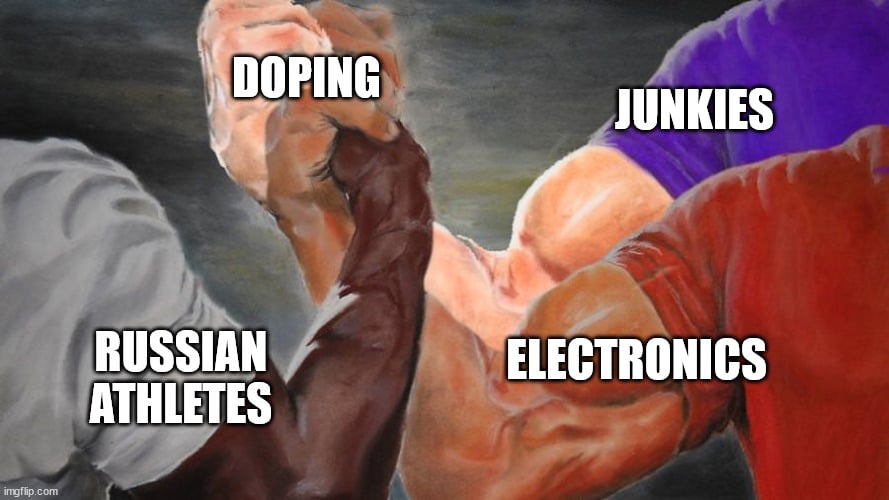I recently read through this and was just curious what others thought the pitfalls or unforseen issues might be with quickly or steadily transitioning to such in a fairly environmentally friendly manner.
Hate the title name, but I think I have to use the article title as the title.
Doping is a common term in electronics, it’s just that the article is on Top Gear so they didn’t explain it well.

The author of this article, smh…
Give him a break, he’s less than a year old! 2 years if you count gpt3.
Good point.
Mainly the issues are about providing ~600 kilowatts for 8 minutes to charge your typical size EV battery.
A row of 5 chargers of that size soaks up 3MW if they’re all in use, and that’s not something that can be quickly or easily shoehorned into a suburban electricity grid.
It’s about 500 houses worth of electricity usage, for comparison. For just 5 fast chargers.
Not to say it’s impossible, but infrastructure doesn’t come cheap, and so it’ll cost quite a bit to cram that 80 percent charge into your car’s battery.
We could be using Hydrogen and fixed MW scale fuel cells at existing refueling locations to fill the gap while transmission and distribution infra catches up, also maintains existing supply chains whilst job roles shift.
What stops us from recycling batteries from vehicles coming off the road and setting them up as not only battery backups for houses on the grid, but also setting up local storages to off-load all the new cars being charged onto the batteries, and just using a constant charge to those throughout the day/night whenever cheapest. Would that not cut all load issues down as we build and as most people would know, our grid on the U.S. actually has less load now because we kept integrating more and more energy efficient items recently (lightbulbs, dishwashers, refrigerators, tvs, dryers, etc.). It isn’t on the same scale many would want, but we stalled on upgrading the grid since before Obamas plan coming in, that was in the debates I remember in 2008. 20 years and hardly any upgrades isn’t the consumers faults, we paid for upgrades over and over and the electric companies are it up and said, well if you want it you need to pay more from everything I have seen.
As far as I can tell (not as an expert), the pitfalls and unforeseen issues are probably pretty much what they’d be for every new battery chemistry: how safe is it? Does it have really bad self-discharge? Is the supply consistent? How does it do at low charging levels? How long/how many cycles does such a cell last? Does it require an unsustainable amount of exotic minerals?
As well as what they are for any new technology: what is the replacement cost? Can they be installed in existing technology via drop-in or with a simple retrofit, or do you have to replace the entire unit? How long before they come to market? Can they maintain supply to match demand?
Probably a lot of those questions are business-related rather than technology-related (i.e. “will the companies developing this stuff put enough into R&D to solve these problems before releasing them?” not “do the laws of the universe allow this?”). I am not an expert, but before I put all my chips on solid-state batteries (something I’m pretty confident will be the norm eventually), I would want those answered.
I’d be afraid of wearing out a battery super fast. Outside of super long trips that require recharging to arrive, I’d much rather leave a car plugged in overnight rather than need to pay to replace batteries. Also, like @[email protected] said, it’s a lot of power at once that could get dangerous if something goes wrong or overload grids if lots of people start fast charging their cars.
Though of course I’m sure it’s a great achievement and hopefully the research is useful.
the power grid should either cope or be destroyed. We cannot let some beaurocrats hold back progress just because they think that utilities should be “reliable” and “safe”.
You from Texas?
No, all three grids US don’t have the power to support most cars becoming electric atm. Heck, on the west coast they occasionally have controlled blackouts because there’s not always enough power as it is. The Texas grid, while having some flaws, would probably be the most agile to be modified on a dime. The US east and west grid need to deal with the US Feds, US States, Canadian Feds, and Canadian provinces and would probably take more time to modernize.
Edit: Copying my below reply for clearification Maybe I should have worded it different. Once in a while places with high population centers have relative power shortages. According to that article the last California controlled blackout due to power shortages was 2022, so it’s not like we’re talking third world regular brownouts or anything.
I just meant it in the way that the power grid is old and was built during a time when we used less power, and while it generally works it’s already at capacity and increasing capacity would require a lot of investment and cooperation.
In this particular case, a small grid controlled by one bureaucratic entity, as apposed to many bureaucratic entities across multiple countries, might be more easily modified. But, to my knowledge, none of them could support a sudden increase in power needs as they are currently (see the several big Texas blackouts, or the above article).
Right Texas power grid good west coast power grid bad…I’m NW born and raised never once dealt with controlled blackouts
Maybe I should have worded it different. Once in a while places with high population centers have relative power shortages. According to that article the last California controlled blackout due to power shortages was 2022, so it’s not like we’re talking third world regular brownouts or anything.
I just meant it in the way that the power grid is old and was built during a time when we used less power, and while it generally works it’s already at capacity and increasing capacity would require a lot of investment and cooperation.
In this particular case, a small grid controlled by one bureaucratic entity, as apposed to many bureaucratic entities across multiple countries, might be more easily modified. But, to my knowledge, none of them could support a sudden increase in power needs as they are currently (see the several big Texas blackouts, or the above article).
on of the other states that has a weir d power grid (several citys and villages have their own)
deleted by creator
Taking this at face value, I note two things:
- This shit would overload our current electricity grid fast!
- This is a terrifying ammount of power going into the car.
As for point 1, the power has to come from somewhere, and our current power grid is already having problems keeping up with current charging currents, and if a battery like this will be able to get charged 80% in 9 min, to use it you have to have a power source to supply that ammount of power in that time.
This could possibly be mitigated somewhat with huge batteries at the charge station that get charged slowly over time and that is then used to boost the charging of the car, but this would need specialized maintenance and commes with big potential risks.
As for point 2, the huge ammounts of power being delivered to the car will require a perfect connection between the power source and the car, it will require heavy insulation in and around the car, I wouldn’t want to be within 10 meters of the car while charging due to potential risk of arc flash.
It’s not such as impressive amount of power compared to existing installations. Say 75 kWh battery. 80% of that would be 60 kWh, charged over 9 minutes. That’s a 400 kW charger. Meanwhile 300 kW are reasonable common and there are a few 500 kW chargers out there. A 500 kW charger would charge the car to 80% in 7 minutes.
Thanks for giving me actual numbers, that makes it sound less insane.
80 % in 9 minutes is only 5 C, not really something that amazing.
It’s still faster than most lithium batteries can charge. They still have a long ways to go to reach the charge rate of super capacitors though.
Most lithium batteries are real, however, and not a stupid lab thing that only performs in one category and no other, while an are needed in the real world.



